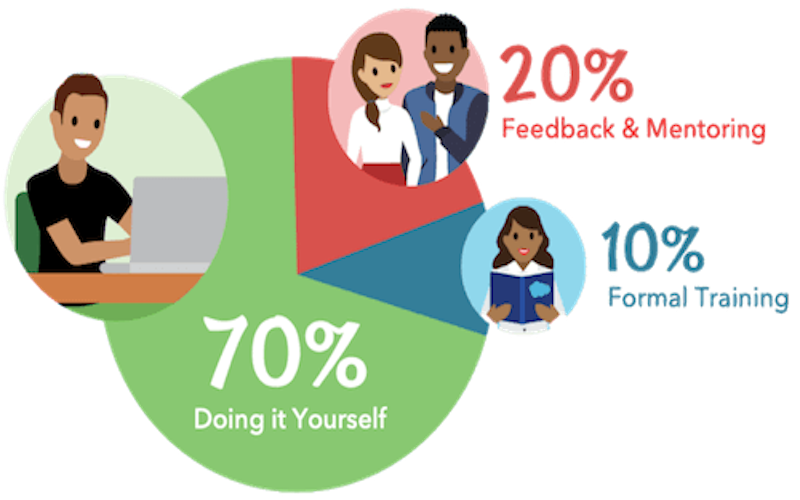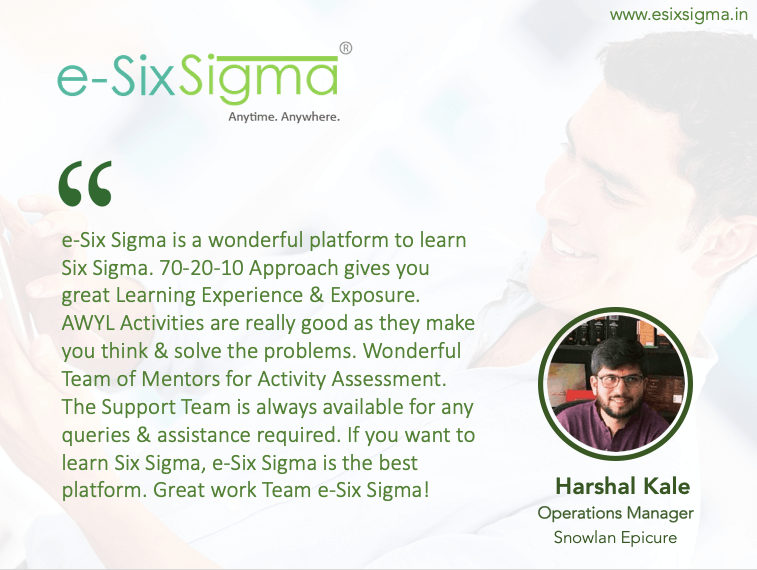Learning is like a pie. To make it tasty, you need to know which ingredients to add and in what proportions. However, we all have been bombarded with a typical mindset that says to learn something new, we need to go to school or college or a training institute! Sounds likely? For most of us, it is likely.
We all have different styles of learning. Some people learns just by listening, some learns by watching but most of us learn by trying it ourselves! I am pretty sure, at some point of time, you must have learnt something new by doing it yourself.
70-20-10 Model of Learning is very much aligned with the same concept.

How it started?
The 70-20-10 Model of Learning was developed by Morgan McCall, Robert Eichinger and Michael Lombardo at the Center for Creative Leadership in the mid-1990s. They surveyed almost 200 executives about their learning philosophy. The results were pretty surprising, and caused a notable shift in the learning world.
The survey states that learning should come from a variety of sources:
- 70% from challenging assignments
- 20% from developmental relationships
- 10% from coursework and training
It’s been a while since then, yet the 7020-10 Model has stood the test of time and is still often used to define the ideal balance for how to train employees, of course with embedding a technology in this modern time.
Formal vs Informal Training
The 70-20-10 Model of Learning isn’t just a numeric sequence. It is a fundamentally different view of work, performance and learning in the 21st century.
The ultimate purpose of learning is its application which happens at work environment. If we translate the core concept into corporate language as-
70% Learning is Experimental. It comes from experiences people face at work. 20% is social or peer to peer learning. It generally happens through mentoring, feedbacks or relationships with colleagues.
Together, these two types comprise informal learning, which occurs outside a classroom environment.
10% is a formal learning that generally happens through a traditional structured courses or training programs.
Effective learning comes down to getting the mix between formal and informal learning.
Benefits of 70-20-10 Model of Learning
In addition to take advantage of every learning opportunity, the 70-20-10 Model of Learning offers plenty of benefits.
70-20-10 Model of Learning states an individual learns 70% by doing it by Self (Experience), 20% by Mentoring & Feedbacks (Exposure) and 10% through Formal Training (Education).
1. Flexibility:
Since 70:20:10 is a reference model and not a formula, it's flexible enough for businesses to use it in a variety of ways. One can learn at his own time convenience and pace of learning without a burden of being a learner as such!
2. Effective Problem Solving
It has been proven that smaller or larger, many problems at work are effectively solved through communities, collaboration, sharing, increased access and greater motivation.
3. Boost in Knolwedge Acquisition
The 70-20-10 Model of Learning pushes up the involvement by offering deep insights which eventually results into the boost in Knowledge Acquisition of the learners.
70-20-10 Model of Learning by e-Six Sigma
e-Six Sigma is an Online Lean Six Sigma Training & Certification Platform, offering Learning Experience through its Award-Winning Training Model based on 70-20-10 Model of Learning.
It focuses on Practical Exposure through Uniquely Designed AWYL- Apply What You Learn Activities. These activities are in the form of Role-Play, Calculations, Data Collection, Research, Presentation, etc to be performed either at your office or a residence without much of an issue. These activities are mandatory for the learners to unlock the next chapter and carry a weightage of 5 points to be considered for final Certification hence learners cannot skip it.

Once submitted, the team of industry experts assesses these activities to provide the personalized feedback to the learners so as to help them understand where they went wrong and how they can improve.
The e-Learning Videos at the beginning of the chapter do the part of formal training along with the Study Material. The videos are short-length, eye-catchy and impactful. The Study Materials are enriched with additional information & real-life examples for better understanding of the topics.
e-Six Sigma is being loved for its state-of-the-art Virtual Infrastructure, World-Class Curriculum, Flexibility of Access, Prompt Support and a Price that is hard to believe!
With more than 2600 Lean Six Sigma Aspirants enjoyed the WOW Learning Experience, you can have a look at the ratings & feedbacks here on our website, Google or Facebook.
Time in money so don’t waste it in waiting. Enrol now in less than a minute and feel the difference!


